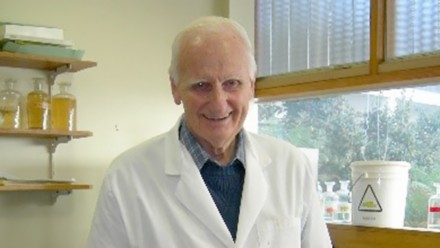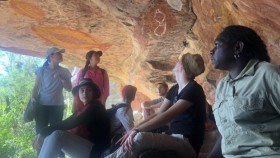Biography of Howard Bradbury
Control of the Crippling Neurological Disease, Konzo
Vale Howard Bradbury

Howard passed away on Monday 28 November 2016.
In memoriam - Emeritus Professor Howard Bradbury.
It was in 1974 that I first saw the poverty and deprivation of life in a developing country. This caused me to change my research orientation from mainly basic research on the chemistry of macromolecules (see previous work, below) to a new interest in the chemistry of food. Food is of course important to all people, everywhere. So I developed research work on rice and sweet potatoes and then we analysed for their nutrients the tropical root crops of the South Pacific countries. This was published as an Australian Centre for International Agricultural Research (ACIAR) monograph in 1988. In December 1988 I took early retirement from teaching and research in the Department of Chemistry at ANU and moved to the Department of Botany, which has subsequently undergone amalgamation and a name change to Ecology and Evolution within the Research School of Biology.
Realising that the most important tropical root crop cassava contained cyanide compounds, which in Africa caused cyanide poisoning sometimes leading to death, as well as neurological diseases such as konzo and tropical ataxic neuropathy, I decided to focus my attention on this field.
Kits to determine cyanide in cassava and thiocyanate in urine
In 1995 we developed a simple method that could be used by a high school student to determine the total cyanide content of cassava roots and cassava products such as flour. We use yellow picrate papers which are turned brown by hydrogen cyanide (HCN) gas, liberated from a small sample of cassava by the enzyme linamarase, that is immobilised in a small filter paper. The colour of the picrate paper is compared with a chart with 10 shades of colour covering the range 0-800 ppm total cyanide, and this is used for field work. For accurate laboratory work the coloured compound is eluted from the paper with water and the absorbance of the solution measured in a spectrometer.
Ingested cyanide is detoxified in the body to thiocyanate which is removed in the urine, hence a urinary thiocyanate measurement shows the total cyanide intake over the preceding days. We developed a urinary thiocyanate kit based on oxidation of thiocyanate by acidified potassium permanganate with quantitative liberation of HCN, which is measured with a picrate paper. As suggested by ACIAR who funded this work, kits allowing 100 analyses for total cyanide or urinary thiocyanate are given away for free to health and agricultural workers in developing countries, and are sold in first world countries, see Konzo Prevention Unit.
Wetting method to remove cyanogens from cassava flour
In 2004-5, I discovered the “wetting method,” to remove cyanide compounds from cassava flour. Cassava flour is placed in a bowl and the level of the flour marked on the inside of the bowl. Water is added with mixing, the volume of the flour initially decreases and then increases until the flour reaches the mark on the bowl. The wet flour is spread out in a thin layer on a mat for two hours in the sun or five hours in the shade to allow HCN gas to escape from the wet flour. This removes nearly all the residual cyanide. The method is a gift from God. The method was checked out in Mozambique, it requires little extra work or equipment and the traditional thick porridge made from treated flour is free of the bitter taste due to linamarin present in the untreated flour. Recently the World Bank, WHO and FAO recognised the wetting method as a sensitive intervention to remove cyanogens from cassava flour. I recommend that the wetting method be used as an additional method to traditional methods to remove cyanogens from cassava flour in tropical Africa.
Control of konzo
Konzo is an upper motor neuron disease of sudden onset that causes irreversible paralysis of the legs mainly in children and in young women particularly after childbirth, due to intake of large amounts of cyanide from bitter cassava roots and flour. Konzo occurs amongst very poor families living in remote villages whose diet is predominantly bitter cassava and also konzo epidemics occur during droughts and as a result of war. Konzo occurs in the Democratic Republic of Congo (DRC), Mozambique, Tanzania, Cameroon, Central African Republic and Angola.In 2010 we started a new collaborative project with Dr J.P. Banea, Director of the National Institute of Nutrition, Kinshasa and coworkers, to prevent konzo in Kay Kalenge village, Bandundu Province, DRC. Kay Kalenge has a population of about 1000 with 34 konzo cases. The women of the village were taught that konzo is due to a poison (cyanide) present in the cassava flour and shown how to use the wetting method. The women accepted the method willingly and found that the thick porridge (fufu) made from treated flour was tastier and stored better than that made from untreated flour. Subsequent projects will focus on introducing the wetting method to a wider audience.
Previous Work and Awards
I studied chemistry at Melbourne Technical College and Melbourne University followed by a PhD in polymer chemistry at Birmingham University. After a postdoctoral fellowship at Harvard University, I worked at CSIRO Wool Research Laboratories and then moved to the Chemistry Department at the Australian National University (ANU) in 1961. I had sabbatical appointments at Cornell University and on three occasions at Oxford University. My major research interests during this period were the chemistry of wool and keratin fibres and subsequently NMR studies of proteins, enzymes and carbohydrates. I was awarded a DSc and the David Syme Research Prize by Melbourne University, the Rennie Memorial Medal and H G Smith Memorial Medal by the Royal Australian Chemical Institute and a DSc by ANU.
I took early retirement in December 1988 from teaching and research in chemistry, and since then have continued to work on konzo and other health problems due to cyanogens present in cassava. In 2007 I was awarded the inaugural "$2 a day award" by the Institution of Chemical Engineers for the discovery of the wetting method. In 2007 I was appointed a Member of the Order of Australia.
Research interests
Control of the Crippling Neurological Disease, Konzo
- Read more on the Konzo Prevention Unit website.
Publications
More publications available here
Bradbury, J.H. and Denton, I.C. (2014) Mild method for removal of cyanogens from cassava leaves with retention of vitamins and protein. Food Chem. 158, 417-420.
Banea, J.P., Nahimana, G., Mandombi, C., Bradbury, J.H., Denton, I.C. and Kuwa, N. (2012) Control of konzo in DRC using the wetting method on cassava flour. Food Chem. Toxicol. 50, 1517-1523.
Bradbury, J.H., Cliff, J. and Denton, I.C. (2011) Uptake of wetting method in Africa to reduce cyanide poisoning and konzo from cassava. Food Chem Toxicol. 49, 539-542.
Cliff, J., Muquingue, H., Nhassico,D., Nzwalo, H, and Bradbury, J.H. (2011) Konzo and continuing cyanide intoxication from cassava in Mozambique. Food Chem Toxicol. 49, 631-635.
Bradbury, J.H. and Denton, I.C (2010) Rapid wetting method to reduce cyanogen content of cassava flour. Food Chem. 121, 591-594.
Bradbury, J.H. and Denton, I.C. (2010) Simple method to reduce the cyanogen content of gari made from cassava. Food Chemistry, 123, 840-845.
Mlingi, N.L.V., Nkya, S., Tatala, S.R., Rashid, S. and Bradbury, J.H. (2011) Recurrence of konzo in southern Tanzania: rehabilitation and prevention using the wetting method. Food Chem Toxicol 49, 673-677.
Bradbury, J.H. (2009) Development of a sensitive picrate method to determine total cyanide and acetone cyanohydrin contents of gari from cassava. Food Chem. 113, 1329-1333.
Bradbury, J.H. (2008) Simple solution fights konzo. tce – The Chemical Engineer, February 2008, 24-25.
Bradbury, J.H. (2006) Simple wetting method to reduce cyanogen content of cassava flour. J Food Comp. Anal., 19, 388-393.
Cardoso, A.P., Mirione, E., Ernesto, M., Massaza, F., Cliff, J., Haque, M. and Bradbury, J.H. (2005) Processing of cassava roots to remove cyanogens. J. Food Comp. Anal. 18, 451-460.
Muquingue, H., Nhassico, D., Cliff, J., Sitoe, L., Tonela, A, and Bradbury, J.H. (2005) Field trial in Mozambique of a new method for detoxifying cassava in cassava products. CCDN News, No 6, 3-4.
Cardoso, A.P., Ernesto, M., Nicala, D., Mirione, E., Chavane, L., N’zwalo, H., Chikumba, S., Cliff, J., Mabota, A.P., Haque, M. and Bradbury, J.H. (2004) Combination of cassava flour cyanide and urinary thiocyanate measurements of school children in Mozambique. Int. J. Food Sci. Nutr. 55, 183-190.
Haque, M., and Bradbury, J.H. (2002). Total cyanide determination of plants and foods using the picrate and acid hydrolysis methods. Food Chem 77, 107-114.
Bradbury, M G, Egan, S V and Bradbury, J H (1999) Picrate paper kits for determination of total cyanogens in cassava roots and all forms of cyanogens in cassava products. J. Sci. Food Agric., 79, 593-601.
Haque, M.R. and Bradbury, J.H.(1999) Simple method for determination of thiocyanate in urine. Clinical Chemistry, 45, 1459-1464
Egan, S.V., Yeoh, H.H. and Bradbury, J.H. (1998) Simple picrate paper kit for determination of the cyanogenic potential of cassava flour. J. Sci. Food Agric.76, 39-48.
Cardoso, A. P., Ernesto, M., Cliff, J., Egan, S. V. and Bradbury, J. H. (1998) Cyanogenic potential of cassava flour: Field trial in Mozambique of a simple kit. Intern J Food Sci Nutr, 49, 93-99.
King, N.L.R. and Bradbury, J.H. (1995) Bitterness of cassava: identification of a new apiosyl glycoside and other compounds that affect its bitter taste. J. Sci.Food Agric. 68, 223-230.
Bradbury, J.H. and Holloway, W. D. 1988. Chemistry of tropical root crops : significance for nutrition and agriculture in the Pacific, Australian Centre for International Agricultural Research (ACIAR). Monograph No 6, 201 pp.
Carver J.A. and Bradbury, J.H. (1984) Assignment of 1H NMR Resonances of Histidine and Other Aromatic Residues in Met, Cyano, Oxy and Carbon Monoxy Myoglobins, Biochemistry, 23, 4890-4905.
Bradbury, J.H. (1973) The structure and chemistry of keratin fibres. Advances in Protein Chemistry, 27, 111- 211.
King, N.L.R. and Bradbury, J.H. (1971) Simplification of the proton magnetic resonance spectroscopy of ribonuclease by difference spectroscopy. Nature 229, 404-406.
Bradbury, J.H. and Scheraga, H.A. (1966) Structural studies of ribonuclease. XXIV Application of NMR spectroscopy to distinguish between the histidine residues of ribonuclease. J. Amer. Chem. Soc. 88, 4240-46.
Doty, P., Bradbury, J.H. and Holtzer, A.M. (1956) Polypeptides IV: The molecular weight, configuration and association of poly-gamma-benzyl glutamate in various solvents. J. Amer. Chem. Soc. 78, 947-954.
Bradbury, J.H. and Melville, H.W (1954) The Copolymerization of Styrene and Butyl Acrylate in Benzene Solution, Proc.Roy.Soc., 222A, 456-470.









